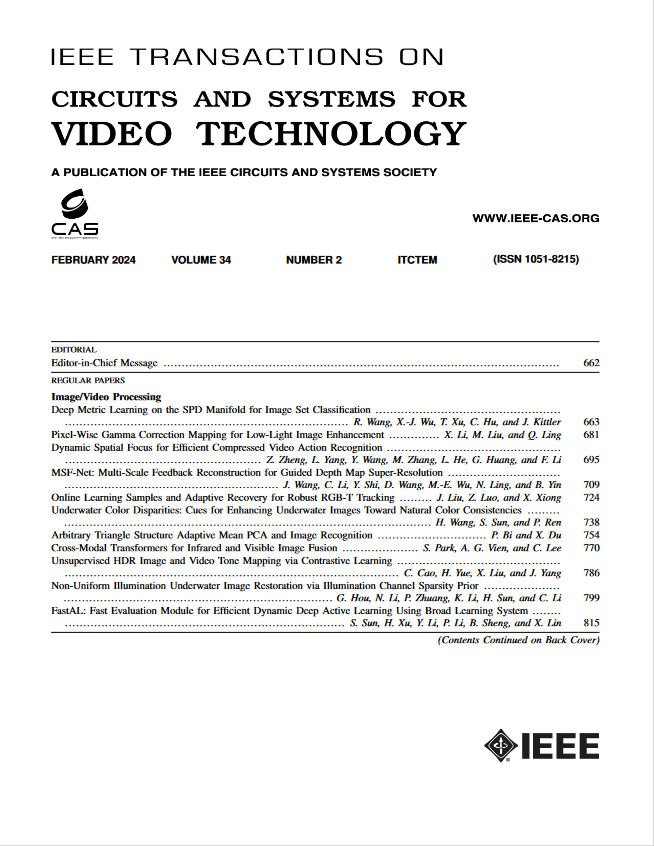MSCoTDet:语言驱动的多模态融合改进的多光谱行人检测
IF 8.3
1区 工程技术
Q1 ENGINEERING, ELECTRICAL & ELECTRONIC
IEEE Transactions on Circuits and Systems for Video Technology
Pub Date : 2024-12-31
DOI:10.1109/TCSVT.2024.3524645
引用次数: 0
摘要
由于RGB和热模态之间的互补信息,多光谱行人检测对于全天候应用具有吸引力。然而,目前的模型在某些情况下往往无法检测到行人(例如,热遮挡的行人),特别是由于从统计偏差数据集中学习到的模态偏差。在本文中,我们研究了如何使用大语言模型(LLM)减轻多光谱行人检测中的模态偏差。因此,我们设计了一种多光谱思维链(MSCoT)提示策略,提示LLM执行多光谱行人检测。此外,我们提出了一种新的多光谱思维链检测(MSCoTDet)框架,该框架将MSCoT提示集成到多光谱行人检测中。为此,我们设计了一种语言驱动的多模态融合(LMF)策略,将MSCoT提示的输出与基于视觉的多光谱行人检测模型的检测结果融合在一起。大量的实验验证了MSCoTDet有效地减轻了模态偏差,提高了多光谱行人检测。本文章由计算机程序翻译,如有差异,请以英文原文为准。
MSCoTDet: Language-Driven Multi-Modal Fusion for Improved Multispectral Pedestrian Detection
Multispectral pedestrian detection is attractive for around-the-clock applications due to the complementary information between RGB and thermal modalities. However, current models often fail to detect pedestrians in certain cases (e.g., thermal-obscured pedestrians), particularly due to the modality bias learned from statistically biased datasets. In this paper, we investigate how to mitigate modality bias in multispectral pedestrian detection using a Large Language Model (LLM). Accordingly, we design a Multispectral Chain-of-Thought (MSCoT) prompting strategy, which prompts the LLM to perform multispectral pedestrian detection. Moreover, we propose a novel Multispectral Chain-of-Thought Detection (MSCoTDet) framework that integrates MSCoT prompting into multispectral pedestrian detection. To this end, we design a Language-driven Multi-modal Fusion (LMF) strategy that enables fusing the outputs of MSCoT prompting with the detection results of vision-based multispectral pedestrian detection models. Extensive experiments validate that MSCoTDet effectively mitigates modality biases and improves multispectral pedestrian detection.
求助全文
通过发布文献求助,成功后即可免费获取论文全文。
去求助
来源期刊
CiteScore
13.80
自引率
27.40%
发文量
660
审稿时长
5 months
期刊介绍:
The IEEE Transactions on Circuits and Systems for Video Technology (TCSVT) is dedicated to covering all aspects of video technologies from a circuits and systems perspective. We encourage submissions of general, theoretical, and application-oriented papers related to image and video acquisition, representation, presentation, and display. Additionally, we welcome contributions in areas such as processing, filtering, and transforms; analysis and synthesis; learning and understanding; compression, transmission, communication, and networking; as well as storage, retrieval, indexing, and search. Furthermore, papers focusing on hardware and software design and implementation are highly valued. Join us in advancing the field of video technology through innovative research and insights.

 求助内容:
求助内容: 应助结果提醒方式:
应助结果提醒方式:


